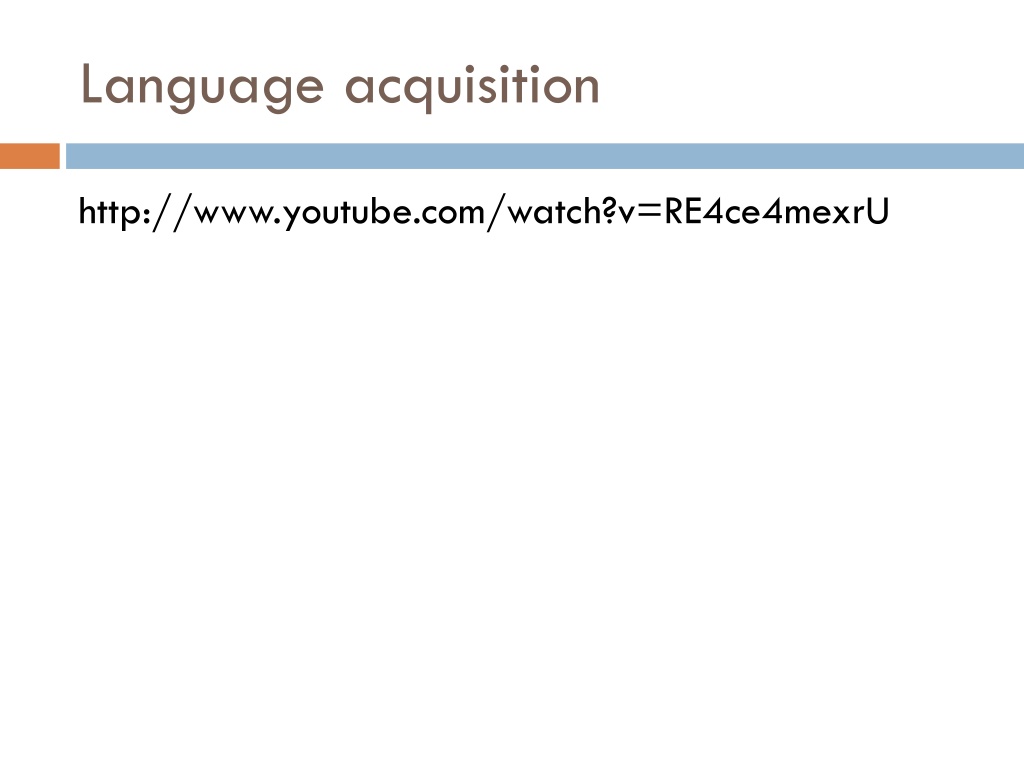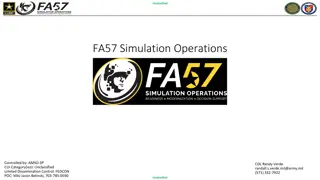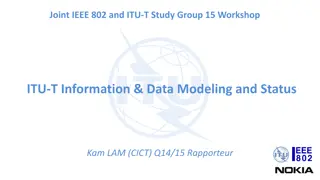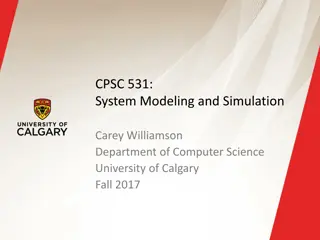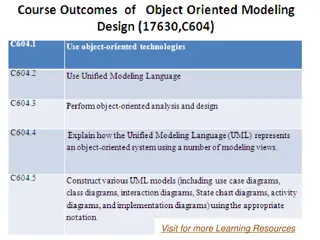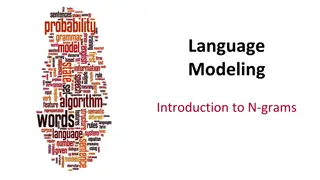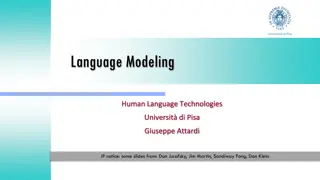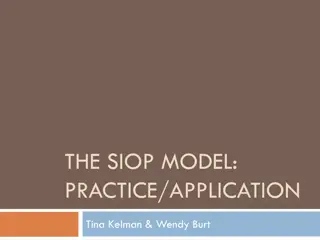Language Acquisition and Modeling
Dive into the world of language acquisition and modeling, exploring topics such as smoothing techniques in language modeling. Uncover the key idea of smoothing to redistribute probabilities for less seen events while maintaining a true distribution. Understand how to handle unseen trigrams effectively and why smoothing plays a crucial role in accurate probability estimates.
Download Presentation

Please find below an Image/Link to download the presentation.
The content on the website is provided AS IS for your information and personal use only. It may not be sold, licensed, or shared on other websites without obtaining consent from the author.If you encounter any issues during the download, it is possible that the publisher has removed the file from their server.
You are allowed to download the files provided on this website for personal or commercial use, subject to the condition that they are used lawfully. All files are the property of their respective owners.
The content on the website is provided AS IS for your information and personal use only. It may not be sold, licensed, or shared on other websites without obtaining consent from the author.
E N D
Presentation Transcript
Language acquisition http://www.youtube.com/watch?v=RE4ce4mexrU
LANGUAGE MODELING: SMOOTHING David Kauchak CS159 Fall 2014 some slides adapted from Jason Eisner
Admin Assignment 2 out bigram language modeling Java Can work with partners Anyone looking for a partner? 2a: Due Thursday 2b: Due Tuesday Style/commenting (JavaDoc) Some advice Start now! Spend 1-2 hours working out an example by hand (you can check your answers with me) HashMap
Admin Assignment submission: submit on-time! Our first quiz (when?) In-class (~30 min.) Topics corpus analysis regular expressions probability language modeling Open book/notes we ll try it out for this one better to assume closed book (30 minutes goes by fast!) 7.5% of your grade
Admin Lab next class Meet in Edmunds 105, 2:45-4pm
Today smoothing techniques
Today Take home ideas: Key idea of smoothing is to redistribute the probability to handle less seen (or never seen) events Still must always maintain a true probability distribution Lots of ways of smoothing data Should take into account features in your data!
Smoothing What if our test set contains the following sentence, but one of the trigrams never occurred in our training data? P(I think today is a good day to be me) = P(I | <start> <start>) x P(think | <start> I) x If any of these has never been seen before, prob = 0! P(today| I think) x P(is| think today) x P(a| today is) x P(good| is a) x
Smoothing P(I think today is a good day to be me) = P(I | <start> <start>) x P(think | <start> I) x These probability estimates may be inaccurate. Smoothing can help reduce some of the noise. P(today| I think) x P(is| think today) x P(a| today is) x P(good| is a) x
The general smoothing problem 1 0 0 2 0 1/3 0/3 0/3 2/3 0/3 ? ? ? ? ? ? ? ? ? ? ? ? ? ? see the abacus see the abbot see the abduct see the above see the Abram 0 0/3 see the zygote 3 3/3 ? ? Total
Add-lambda smoothing A large dictionary makes novel events too probable. add = 0.01 to all counts 1 0 0 2 0 1/3 0/3 0/3 2/3 0/3 1.01 0.01 0.01 2.01 0.01 0.01 0.01 1.01/203 0.01/203 0.01/203 2.01/203 0.01/203 0.01/203 0.01/203 see the abacus see the abbot see the abduct see the above see the Abram 0 0/3 see the zygote 3 3/3 203 Total
Add-lambda smoothing How should we pick lambda? 1 0 0 2 0 1/3 0/3 0/3 2/3 0/3 1.01 0.01 0.01 2.01 0.01 0.01 0.01 1.01/203 0.01/203 0.01/203 2.01/203 0.01/203 0.01/203 0.01/203 see the abacus see the abbot see the abduct see the above see the Abram 0 0/3 see the zygote 3 3/3 203 Total
Setting smoothing parameters Idea 1: try many values & report the one that gets the best results? Training Test Is this fair/appropriate?
Setting smoothing parameters Training Test Dev. Training and report results of that final model on test data. Now use that to get smoothed counts from all 100% pick that gets best results on 20% collect counts from 80% of the data 14 problems? ideas?
Vocabulary n-gram language modeling assumes we have a fixed vocabulary why? Whether implicit or explicit, an n-gram language model is defined over a finite, fixed vocabulary What happens when we encounter a word not in our vocabulary (Out Of Vocabulary)? If we don t do anything, prob = 0 Smoothing doesn t really help us with this!
Vocabulary To make this explicit, smoothing helps us with all entries in our vocabulary 1 0 0 2 0 1.01 0.01 0.01 2.01 0.01 0.01 0.01 see the abacus see the abbot see the abduct see the above see the Abram 0 see the zygote
Vocabulary and Vocabulary Counts Smoothed counts a able about account acid across young zebra 10.01 1.01 2.01 0.01 0.01 3.01 1.01 0.01 10 1 2 0 0 3 1 0 How can we have words in our vocabulary we ve never seen before?
Vocabulary Choosing a vocabulary: ideas? Grab a list of English words from somewhere Use all of the words in your training data Use some of the words in your training data for example, all those the occur more than k times Benefits/drawbacks? Ideally your vocabulary should represents words you re likely to see Too many words: end up washing out your probability estimates (and getting poor estimates) Too few: lots of out of vocabulary
Vocabulary No matter your chosen vocabulary, you re still going to have out of vocabulary (OOV) How can we deal with this? Ignore words we ve never seen before Somewhat unsatisfying, though can work depending on the application Probability is then dependent on how many in vocabulary words are seen in a sentence/text Use a special symbol for OOV words and estimate the probability of out of vocabulary
Out of vocabulary Add an extra word in your vocabulary to denote OOV (<OOV>, <UNK>) Replace all words in your training corpus not in the vocabulary with <UNK> You ll get bigrams, trigrams, etc with <UNK> p(<UNK> | I am ) p(fast | I <UNK> ) During testing, similarly replace all OOV with <UNK>
Choosing a vocabulary A common approach (and the one we ll use for the assignment): Replace the first occurrence of each word by <UNK> in a data set Estimate probabilities normally Vocabulary then is all words that occurred two or more times This also discounts all word counts by 1 and gives that probability mass to <UNK>
Storing the table How are we storing this table? Should we store all entries? 1 0 0 2 0 1/3 0/3 0/3 2/3 0/3 1.01 0.01 0.01 2.01 0.01 0.01 0.01 1.01/203 0.01/203 0.01/203 2.01/203 0.01/203 0.01/203 0.01/203 see the abacus see the abbot see the abduct see the above see the Abram 0 0/3 see the zygote 3 3/3 203 Total
Storing the table Hashtable (e.g. HashMap) fast retrieval fairly good memory usage Only store those entries of things we ve seen for example, we don t store |V|3 trigrams For trigrams we can: Store one hashtable with bigrams as keys Store a hashtable of hashtables (I m recommending this)
Storing the table: add-lambda smoothing For those we ve seen before: add-lambda smoothing Unsmoothed (MLE) P(c|ab)=C(abc)+l P(c|ab)=C(abc) C(ab)+? C(ab) see the abacus 1 1/3 1.01 1.01/203 see the abbot 0 0/3 0.01 0.01/203 What value do we need here to make sure it stays a probability distribution? see the abduct 0 0/3 0.01 0.01/203 see the above 2 2/3 2.01 2.01/203 see the Abram 0 0/3 0.01 0.01/203 0.01 0.01/203 see the zygote 0 0/3 0.01 0.01/203 Total 3 3/3 203
Storing the table: add-lambda smoothing For those we ve seen before: add-lambda smoothing Unsmoothed (MLE) P(c|ab)=C(abc)+l C(ab)+lV P(c|ab)=C(abc) C(ab) see the abacus 1 1/3 1.01 1.01/203 see the abbot 0 0/3 0.01 0.01/203 For each word in the vocabulary, we pretend we ve seen it times more (V = vocabulary size). see the abduct 0 0/3 0.01 0.01/203 see the above 2 2/3 2.01 2.01/203 see the Abram 0 0/3 0.01 0.01/203 0.01 0.01/203 see the zygote 0 0/3 0.01 0.01/203 Total 3 3/3 203
Storing the table: add-lambda smoothing For those we ve seen before: P(c |ab)=C(abc)+ l C(ab)+ lV Unseen n-grams: p(z|ab) = ? l P(z|ab)= C(ab)+lV
Problems with frequency based smoothing The following bigrams have never been seen: p( X | San ) p( X| ate) Which would add-lambda pick as most likely? Which would you pick?
Witten-Bell Discounting Some words are more likely to be followed by new words food apples bananas hamburgers a lot for two grapes Diego Francisco Luis Jose Marcos San ate
Witten-Bell Discounting Probability mass is shifted around, depending on the context of words If P(wi | wi-1, ,wi-m) = 0, then the smoothed probability PWB(wi | wi-1, ,wi-m) is higher if the sequence wi-1, ,wi-m occurs with many different words wk
Problems with frequency based smoothing The following trigrams have never been seen: p( car | see the ) p( zygote | see the ) p( cumquat | see the ) Which would add-lambda pick as most likely? Witten-Bell? Which would you pick?
Better smoothing approaches Utilize information in lower-order models Interpolation Combine probabilities of lower-order models in some linear combination Backoff C*(xyz) C(xy) a(xy)P(z | y) otherwise if C(xyz) > k P(z | xy) = Often k = 0 (or 1) Combine the probabilities by backing off to lower models only when we don t have enough information
Smoothing: Simple Interpolation P(z | xy) lC(xyz) C(xy)+mC(yz) C(y)+(1-l-m)C(z) C( ) Trigram is very context specific, very noisy Unigram is context-independent, smooth Interpolate Trigram, Bigram, Unigram for best combination How should we determine and ?
Smoothing: Finding parameter values Just like we talked about before, split training data into training and development Try lots of different values for on heldout data, pick best Two approaches for finding these efficiently EM (expectation maximization) Powell search see Numerical Recipes in C
Backoff models: absolute discounting Pabsolute(z | xy) = C(xyz)-D if C(xyz) >0 C(xy) a(xy)Pabsolute(z | y) otherwise Subtract some absolute number from each of the counts (e.g. 0.75) How will this affect rare words? How will this affect common words?
Backoff models: absolute discounting Pabsolute(z | xy) = C(xyz)-D if C(xyz) >0 C(xy) a(xy)Pabsolute(z | y) otherwise Subtract some absolute number from each of the counts (e.g. 0.75) will have a large effect on low counts (rare words) will have a small effect on large counts (common words)
Backoff models: absolute discounting Pabsolute(z | xy) = C(xyz)-D if C(xyz) >0 C(xy) a(xy)Pabsolute(z | y) otherwise What is (xy)?
Backoff models: absolute discounting trigram model: p(z|xy) (before discounting) trigram model p(z|xy) (after discounting) bigram model p(z|y)* (*for z where xyz didn t occur) (xyz occurred) seen trigrams (xyz occurred) seen trigrams (xyz didn t unseen words occur Pabsolute(z | xy) = C(xyz)-D if C(xyz) >0 C(xy) a(xy)Pabsolute(z | y) otherwise
Backoff models: absolute discounting see the dog see the cat see the banana see the man see the woman see the car 1 2 4 1 1 1 p( cat | see the ) = ? p( puppy | see the ) = ? Pabsolute(z | xy) = C(xyz)-D if C(xyz) >0 C(xy) a(xy)Pabsolute(z | y) otherwise
Backoff models: absolute discounting see the dog see the cat see the banana see the man see the woman see the car 1 2 4 1 1 1 p( cat | see the ) = ? 2-D 10 =2-0.75 10 =.125 Pabsolute(z | xy) = C(xyz)-D if C(xyz) >0 C(xy) a(xy)Pabsolute(z | y) otherwise
Backoff models: absolute discounting see the dog see the cat see the banana see the man see the woman see the car 1 2 4 1 1 1 p( puppy | see the ) = ? (see the) = ? How much probability mass did we reserve/discount for the bigram model? Pabsolute(z | xy) = C(xyz)-D if C(xyz) >0 C(xy) a(xy)Pabsolute(z | y) otherwise
Backoff models: absolute discounting see the dog see the cat see the banana see the man see the woman see the car 1 2 4 1 1 1 p( puppy | see the ) = ? (see the) = ? # of typesstarting with see the * D count( seethe ) For each of the unique trigrams, we subtracted D/count( seethe ) from the probability distribution Pabsolute(z | xy) = C(xyz)-D if C(xyz) >0 C(xy) a(xy)Pabsolute(z | y) otherwise
Backoff models: absolute discounting see the dog see the cat see the banana see the man see the woman see the car 1 2 4 1 1 1 p( puppy | see the ) = ? (see the) = ? # of typesstarting with see the * D count( seethe ) reserved_mass(see the)=6*D =6*0.75 10 =0.45 10 Pabsolute(z | xy) = C(xyz)-D distribute this probability mass to all bigrams that we are backing off to if C(xyz) >0 C(xy) a(xy)Pabsolute(z | y) otherwise
Calculating We have some number of bigrams we re going to backoff to, i.e. those X where C(see the X) = 0, that is unseen trigrams starting with see the When we backoff, for each of these, we ll be including their probability in the model: P(X | the) is the normalizing constant so that the sum of these probabilities equals the reserved probability mass a(seethe)* =reserved_mass(see the) p(X| the) X:C(see the X) == 0
Calculating We can calculate two ways Based on those we haven t seen: a(see the)=reserved_mass(see the) p(X | the) X:C(see the X) = 0 Or, more often, based on those we do see: a(see the)=reserved_mass(see the) 1- X:C(see the X) > 0 p(X | the)
Calculating in general: trigrams Calculate the reserved mass # of types starting with bigram * D reserved_mass(bigram) = count(bigram) Calculate the sum of the backed off probability. For bigram A B : p(X | B) 1- p(X | B) either is fine, in practice the left is easier X:C(A B X) = 0 X:C(A B X) > 0 Calculate 1 the sum of the bigram probabilities of those trigrams that we saw starting with bigram A B a(A B) =reserved_mass(A B) 1- X:C(A B X) > 0 p(X | B)
Calculating in general: bigrams Calculate the reserved mass # of types starting with unigram * D reserved_mass(unigram) = count(unigram) Calculate the sum of the backed off probability. For bigram A B : p(X) 1- p(X) either is fine in practice, the left is easier X:C(A X) = 0 X:C(A X) > 0 Calculate 1 the sum of the unigram probabilities of those bigrams that we saw starting with word A a(A) =reserved_mass(A) 1- p(X) X:C(A X) > 0
Calculating backoff models in practice Store the s in another table If it s a trigram backed off to a bigram, it s a table keyed by the bigrams If it s a bigram backed off to a unigram, it s a table keyed by the unigrams Compute the s during training After calculating all of the probabilities of seen unigrams/bigrams/trigrams Go back through and calculate the s (you should have all of the information you need) During testing, it should then be easy to apply the backoff model with the s pre-calculated
Backoff models: absolute discounting the Dow Jones the Dow rose the Dow fell 10 5 5 p( jumped | the Dow ) = ? What is the reserved mass? # of typesstarting with see the * D count( seethe ) reserved_mass(the Dow)=3*D =3*0.75 20 =0.115 20 a(the Dow)=reserved_mass(see the) 1- p(X | the) X:C(the Dow X) > 0
Backoff models: absolute discounting # of types starting with bigram * D reserved_mass = count(bigram) Two nice attributes: decreases if we ve seen more bigrams should be more confident that the unseen trigram is no good increases if the bigram tends to be followed by lots of other words will be more likely to see an unseen trigram
